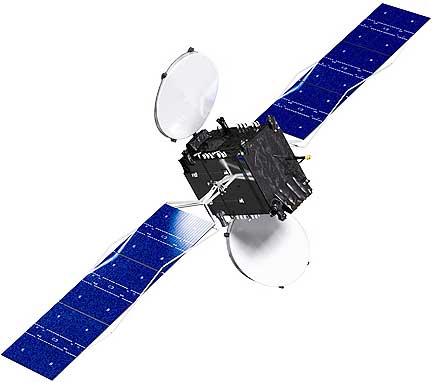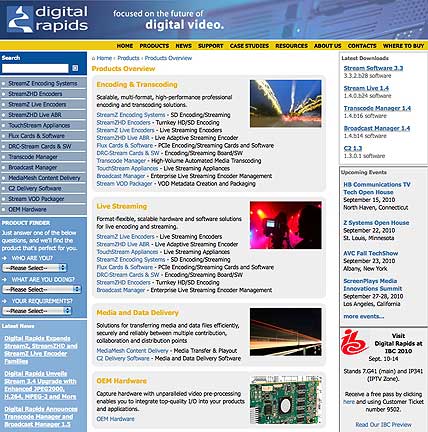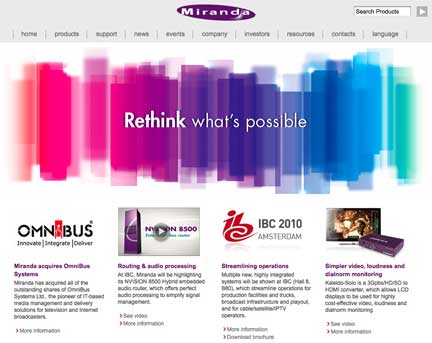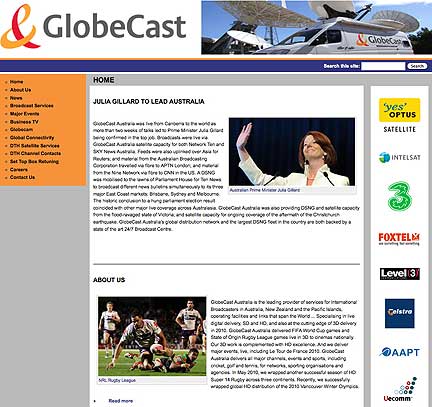Encompass Digital Media, Inc., which operates two of the largest, independent broadcast facilities in the U.S. located in Los Angeles and Atlanta, has announced that Don Gabriel has been appointed as Vice President of Sales. In this position, he will oversee the company’s sales force as well as identify and manage new client relationships. As a key executive, he will also focus on implementing innovative strategies that will support Encompass’ growth platform. Gabriel joins Encompass from EchoStar Satellite Services, where he served as General Manager of Sales. Prior to this position, he was Director of Media and Entertainment Sales for Loral Skynet.
Entropic Communications, Inc. (Nasdaq:ENTR) announced its Channel Stacking Switch (CSS) technology has been deployed by Via Embratel, company held by Empresa Brasileira de Telecomunicacoes S.A. to deliver direct-broadcast satellite (DBS) entertainment services to consumers' homes via a single cable wire infrastructure. By adopting Entropic's CSS technology, Via Embratel can better serve customers in multiple-dwelling unit (MDU) environments by supporting multiple tuners over a single cable, enabling easy plug-and-play STB upgrades, and reaching potential new subscribers, previously unserviceable due to access limitations or wiring restrictions. Entropic's CSS technology enables the delivery of multiple video streams over a single cable. This is critical, as many Brazilian MDUs only have DBS access via a single coax line, where the cost difference for adding or upgrading DBS service into an apartment — off the traditional trunk system versus a CSS truck system — is substantial. Via Embratel can now provide access to available programming for as many as eight tuners within a single cable run from the satellite dish, keeping installation costs at a minimum and, in many cases, enabling DBS service where it would otherwise be impossible to deliver. By installing the multi-switch product into the MDU's existing trunk system, Via Embratel is able to quickly convert customers to their DBS service with no new wires.
Harris... @ IBC2010 Serving Up A Volt — Harris Corporation (NYSE: HRS) is adding significant product introductions to its NEXIO® video server portfolio, designed to help broadcasters accelerate time-to-air, reduce costs and streamline workflows in both playout and production environments. IBC2010 marks the European debut of NEXIO Volt™, a small form-factor, high-performance baseband video server equipped with 2 TB of RAID 3-protected integrated media storage. Offering support for as many as four mixed SD/HD or SD-only baseband channels in a 1RU package, the high-density NEXIO Volt integrates easily into environments where space is at a premium. It reduces power consumption and lowers operating costs — without sacrificing functionality or flexibility. NEXIO Volt is ideal for applications including disaster recovery, edge server, on-air cache, production playout and ingest-to-archive. Built on the same technology as the award-winning NEXIO AMP® server, NEXIO Volt offers software-enabled license keying that allows customers to pay for only the channels and resolutions they need, and easily upgrade to more channels or HD at anytime. A simple software reconfiguration enables NEXIO Volt to attach to NEXIO shared storage as system requirements increase.
Harris also introduced NEXIO Farad™, a high-performance online storage system ideal for large-scale ingest, editing and playout for production, sports, news and live-event applications, delivering the highest levels of bandwidth and storage capacity to support even the most demanding multiplatform media delivery workflows. NEXIO Farad is designed for customers requiring more than 10,000 Mb/s bandwidth and more than 58 TB storage capacity. NEXIO Farad makes building a storage system that meets individual needs simple, thanks to its scale-out architecture, which allows bandwidth and capacity to be accommodated independently of each other. Customers can achieve the system design they need, without compromising on performance, channel count, file-based I/O or their preference of compression technology. The system is equipped with inherent RAID-601 storage protection to maintain system performance and resilience, and provide complete redundancy and backup without degrading system performance. Coupled with unattended, fully automatic drive rebuilds and a system monitoring and notifications system, NEXIO Farad represents the state of the art for high-performance, online, true shared storage.
 Juniper Networks(R) (NYSE: JNPR) announced regional business TV channel CNBC Asia Pacific has deployed its high-performance Ethernet switches to support live broadcasting from the Singapore Exchange. The Juniper Networks EX4200 Ethernet Switches are part of a complete end-to-end IP solution implemented by Nevion, a Juniper partner that addresses the broadcaster's need for multiple video links in real-time. The solution enables CNBC Asia Pacific to reduce its transmission costs by substituting Gigabit Ethernet for multiple point-to-point video links. At the same time, it provides greater scalability, allowing transmission of up to 15 SD-SDI video streams, and enhanced production capabilities with interactive communication between sites.
Juniper Networks(R) (NYSE: JNPR) announced regional business TV channel CNBC Asia Pacific has deployed its high-performance Ethernet switches to support live broadcasting from the Singapore Exchange. The Juniper Networks EX4200 Ethernet Switches are part of a complete end-to-end IP solution implemented by Nevion, a Juniper partner that addresses the broadcaster's need for multiple video links in real-time. The solution enables CNBC Asia Pacific to reduce its transmission costs by substituting Gigabit Ethernet for multiple point-to-point video links. At the same time, it provides greater scalability, allowing transmission of up to 15 SD-SDI video streams, and enhanced production capabilities with interactive communication between sites.
Miranda Technologies Inc. has acquired all of the outstanding shares of privately held OmniBus Systems Ltd., the IT-based media management and delivery solutions company for television and Internet broadcasters, from Palamon Capital Partners, a pan European private equity firm. The all cash purchase, valued at CDN$48.7 million, will be financed equally between cash on hand and an existing credit facility. OmniBus Systems, based in Loughborough, UK, had revenues of approximately CDN$24 million for the trailing last 12 months ended June 30 2010. It has a large installed blue chip customer base, including ABC, Ascent Media, Astro, AT&T, BBC, Chellomedia, Corus, Direct TV, Discovery, E!, FOX, SkyPerfect TV, Starz, and Turner. OmniBus Systems’ iTX is a software-based television production and transmission solution, built on standard IT hardware and advanced software technology. Broadcasters and media operators can use a single, integrated system to unify and streamline ingest, media management, workflow organization, schedule management, asset management, automation, master control and playout to television, radio and the internet. Handling all stages of the production and delivery process under a consistent user environment, the iTX system delivers unprecedented increases in efficiency, scalability and speed of response for media businesses.

Optus D1 satellite







